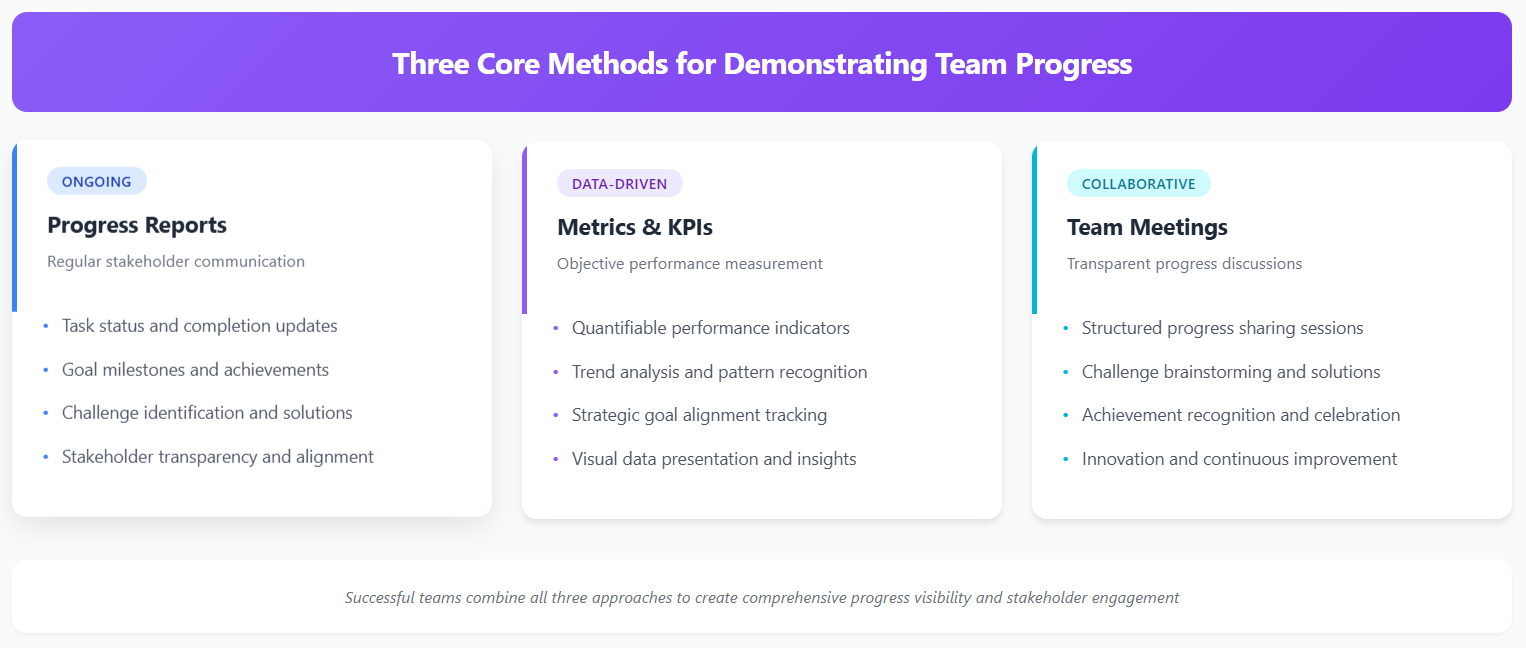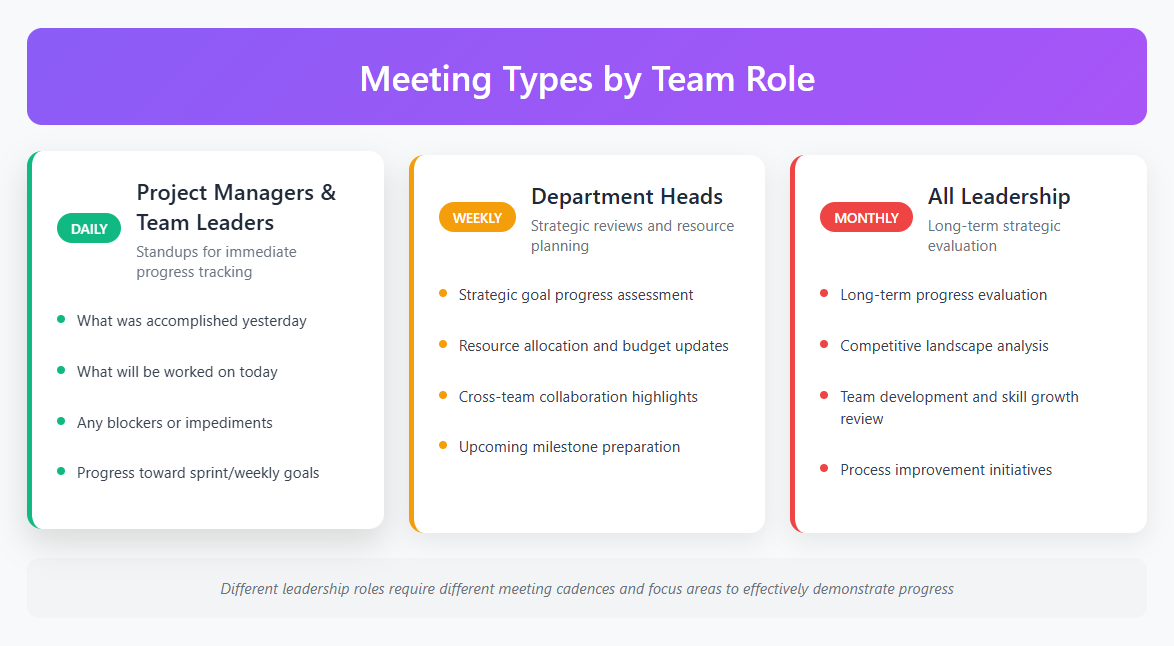Did you know that teams who effectively showcase their progress are up to 70% more likely to achieve their goals?
It's true! In today's fast-paced, results-driven world, simply making progress isn't enough; you have to show it. But how does a team demonstrate progress in a way that's both engaging and effective?
In this article, we’ll explore:
- Practical methods to demonstrate team achievements
- Key indicators that reflect team development
- Common challenges in demonstrating progress
- Actionable strategies to turn progress into competitive advantage
Best ways to demonstrate progress in team projects

Understanding the importance of demonstrating progress is the first step; implementing effective methods is the next.
The most successful teams rely on three core approaches:
- Regular progress reports that keep stakeholders informed
- Performance metrics and KPIs that provide objective measurement
- Team meetings that foster transparency and collaboration
Here are actionable methods that teams can use to showcase their progress in a more engaging and detailed manner:
1. Regular progress reports
✔️Consistent updates
Regular progress reports are crucial for showcasing ongoing accomplishments and keeping everyone informed. These reports should detail tasks completed, goals achieved, and challenges overcome, providing a clear picture of the team's efforts and outcomes.
A thorough progress report includes several key elements:
- Task Status: Detailed updates on completed tasks and those still in progress, highlighting any significant milestones reached.
- Goal Milestones: Information on both short-term and long-term goals achieved, along with the steps taken to reach them.
- Challenges: Insights into any obstacles faced by the team and the solutions implemented to overcome them.
✔️Stakeholder communication
Progress reports serve as a vital communication tool for stakeholders, ensuring that they are well informed about the team’s activities. This transparency helps build trust and keeps everyone aligned with the team’s objectives.
Since modern teams often work across time zones and locations, consider implementing:
- Automated dashboards that stakeholders can access 24/7 for real-time project updates
- Asynchronous video updates for teams in different time zones
- Shared digital workspaces where progress is visible to all team members continuously
✔️Trend analysis
Regular analysis of these reports can reveal trends and patterns in the team's performance. By understanding these trends, teams can make informed decisions and strategic adjustments to further enhance productivity and efficiency.
For example, if reports show consistent delays in specific tasks, the team can investigate the root causes and implement corrective measures.
2. Performance metrics and KPIs
Utilizing performance metrics and Key Performance Indicators (KPIs) allows teams to measure and communicate their progress in a clear, objective manner.
Performance metrics and KPIs offer valuable insights into the team’s strengths and areas that need improvement. By focusing on these key indicators, teams can prioritize their efforts effectively and ensure their actions are aligned with strategic goals.
For instance, if a sales team notices a decline in new customer acquisitions, they can analyze the data to identify potential reasons and develop targeted strategies to address the issue.
Setting specific metrics
It’s important to define precise and relevant KPIs that align with the team's objectives. Here are a few examples:
- Sales Teams: Metrics like the number of sales closed, revenue generated, and new customer acquisitions.
- Development Teams: Indicators such as the number of features developed, bug fixes, and sprint completion rates.
- Marketing Teams: Metrics including lead generation, conversion rates, and social media engagement.
Different positions require different metrics to truly showcase their team's impact. Here's how to align your progress metrics with your specific role and responsibilities:

Regular tracking of these metrics is essential to demonstrate growth and success over time. Visual aids such as charts and graphs can be used to present this data in an easily understandable format.
3. Team meetings and discussions
Team meetings and discussions provide an excellent opportunity for members to share updates, discuss challenges, and celebrate achievements. These interactions are crucial for maintaining transparency and fostering a collaborative environment.
To ensure meetings are productive and efficient, it’s important to have a structured format:
- Agendas: Set clear agendas to keep the meetings focused and on track.
- Updates: Allow each member to provide brief updates on their tasks and progress.
- Challenges: Create a space for discussing any obstacles faced and brainstorming potential solutions.
- Achievements: Take time to highlight and celebrate the team's accomplishments.
Brainstorming and innovation
Regular meetings help to strengthen relationships within the team, creating a positive environment that reflects progress. They also offer a platform for brainstorming new ideas and addressing any concerns.
Encouraging open communication and active participation can enhance problem-solving capabilities and drive innovation within the group. For example, a marketing team might use these meetings to develop creative campaigns or refine their strategies based on recent performance data.
By incorporating these methods, teams can effectively showcase their progress, ensuring that all members and stakeholders are informed and engaged. This approach not only showcases achievements but also fosters continuous improvement and alignment with strategic objectives.
Meeting types by team role
Different leadership roles require different meeting cadences and focus areas for a team to effectively demonstrate progress in their workplace. Here's how to structure progress-focused meetings based on your position and responsibilities:

Daily Standups (for Project Managers and Team Leaders):
- What was accomplished yesterday
- What will be worked on today
- Any blockers or impediments
- Progress toward sprint/weekly goals
Weekly Reviews (for Department Heads):
- Strategic goal progress assessment
- Resource allocation and budget updates
- Cross-team collaboration highlights
- Upcoming milestone preparation
Monthly Strategic Sessions (for All Leadership):
- Long-term progress evaluation
- Competitive landscape analysis
- Team development and skill growth review
- Process improvement initiatives
Key indicators of team progress
Tracking and measuring team progress requires identifying key indicators that showcase the team's development and achievements. Let's explore some of these indicators:
✔️Meeting project milestones
One of the primary indicators of team progress is meeting project milestones. When a team successfully completes important tasks and reaches predefined goals within the set timelines, it signifies progress.
Project milestones serve as checkpoints that help the team track their progress and ensure they are on the right path toward project completion. Achieving these milestones not only demonstrates the team's efficiency and effectiveness but also boosts morale and motivation.
✔️Improvement in team skills
Another significant example of team progress is the improvement in team members' skills. This includes:
- Enhancing technical expertise
- Developing stronger communication skills
- Building leadership skills
Team growth and development directly contribute to overall progress. Investing in skill development not only benefits individual team members but also enhances the overall team performance.
As team members acquire new skills and knowledge, they become more versatile and capable of handling diverse challenges, ultimately leading to improved project outcomes.
Quantifying Skill Development:
- Certification Tracking: Monitor professional certifications earned
- Internal Skill Assessments: Regular evaluations of technical and soft skills
- Cross-Training Metrics: Measure team members' ability to handle diverse tasks
- Mentorship Programs: Track mentor-mentee relationships and outcomes
✔️Positive feedback and recognition
Receiving positive feedback and recognition from stakeholders, clients, or supervisors is a clear sign of team progress. It indicates that the team's efforts and results are being acknowledged and appreciated.
Positive feedback serves as validation of the team's hard work and dedication. This includes:
- Reinforcing a sense of accomplishment and pride among team members
- Fostering a positive team culture
- Motivating individuals to continue striving for excellence in their work
Modern Recognition Metrics:
- Net Promoter Score (NPS): Measure stakeholder satisfaction and likelihood to recommend
- 360-Degree Feedback: Comprehensive evaluation from peers, subordinates, and supervisors
- Client Retention Rates: Long-term indicator of team value delivery
- Internal Awards and Recognition: Track formal acknowledgments within the organization
Tools for monitoring team progress: 5 practical examples
The right tools transform team progress tracking from a time-consuming task into an automated advantage. Here are the five most effective tools that successful teams use to monitor progress:
1. Kanban boards
Kanban boards provide visual workflow management that shows task progress at a glance. Teams can see exactly where each task stands and identify bottlenecks before they become problems.
Key benefits:
- Visual task progression from "To Do" to "Done"
- Easy identification of workflow bottlenecks
- Real-time collaboration and updates
- Simple drag-and-drop task management
2. Gantt charts
Gantt charts excel at timeline visualization and dependency tracking for complex projects. They show how tasks connect and impact overall project completion dates.
Essential features:
- Project timeline visualization
- Task dependency mapping
- Resource allocation tracking
- Deadline and milestone monitoring
3. Time tracking tools
Time tracking reveals where your team's efforts actually go versus where they should go. This data helps optimize workflow efficiency and accurate project estimation.
Core capabilities:
- Automatic time capture for tasks
- Productivity analytics and reporting
- Project time allocation insights
- Billable hours tracking
4. Project dashboards
Dashboards provide centralized views of key metrics and project health indicators. They offer instant visibility into team performance and project status for stakeholders.
Critical functions:
- Real-time progress visualization
- KPI monitoring and alerts
- Customizable metric displays
- Automated status reporting
5. Communication platforms
Integrated communication tools keep progress updates flowing naturally without constant meetings. They centralize project discussions and maintain information transparency.
Must-have features:
- Project-specific channels and threads
- File sharing and collaboration
- Integration with task management
- Mobile accessibility for remote teams
Tool Selection Tip: Choose tools that integrate well together. The most successful teams use 3-4 connected tools rather than switching between multiple disconnected platforms.
Challenges in showcasing team progress
While highlighting team progress is crucial, it does come with its own set of challenges. Let's take a closer look at some common obstacles teams might face:

❌Lack of clear goals
Without a clear goal or defined milestones, it's difficult to measure achievements and track team progress.
Imagine a team embarking on a journey without a destination in mind. They may be working hard, but without a clear goal, their efforts can seem aimless. It's like driving without a GPS; you may be moving, but you have no idea if you're getting closer to your desired location.
❌Ineffective communication
Poor communication can hinder a team's ability to show progress. When information is not shared transparently or effectively, it becomes challenging for stakeholders to understand the team's achievements and growth.
Think of communication as the glue that holds a team together. Without clear and open lines of communication, team members may be working in silos, unaware of each other's progress.
It's like trying to assemble a puzzle without looking at the picture on the box; you may have all the pieces, but without communication, you won't know how they fit together.
❌Resistance to change
Resistance to change can impede team progress, making it difficult to showcase innovation or improvement. When individuals resist new ideas or processes, it’s like swimming against the current; progress becomes an uphill battle.
Overcoming this resistance requires:
- Patience: Understanding that change takes time.
- Open-mindedness: Encouraging team members to consider new approaches.
- Adaptability: Being willing to adjust strategies as needed.
These elements are crucial in overcoming resistance. While the challenges in displaying team progress are significant, with the right strategies and mindset, teams can overcome these obstacles and effectively showcase their achievements.
Turn progress into your team's competitive advantage
Teams that master the art of demonstrating progress don't just achieve their goals, they exceed them! Progress reports, meaningful KPIs, and transparent communication create a culture where achievements are visible and celebrated.
Start today: choose one method from this guide and implement it this week. Small changes in how you showcase progress lead to exponential improvements in team performance.
Ready to take your team's progress tracking to the next level? Discover how Dart AI can help you implement intelligent solutions that make showing team progress effortless and impactful.



_light%201.png)





